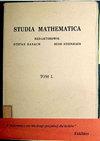The Cauchy dual subnormality problem via de Branges–Rovnyak spaces
IF 0.9
3区 数学
Q2 MATHEMATICS
引用次数: 3
Abstract
The Cauchy dual subnormality problem (for short, CDSP) asks whether the Cauchy dual of a 2-isometry is subnormal. In this paper, we address this problem for cyclic 2-isometries. In view of some recent developments in operator theory on function spaces (see [4, 22]), one may recast CDSP as the problem of subnormality of the Cauchy dual M ′ z of the multiplication operator Mz acting on a de BrangesRovnyak space H(B), where B is a vector-valued rational function. The main result of this paper characterizes the subnormality of M ′ z on H(B) provided B is a vector-valued rational function with simple poles. As an application, we provide affirmative solution to CDSP for the Dirichlettype spaces D(μ) associated with measures μ supported on two antipodal points of the unit circle. 1. Cauchy dual subnormality problem for 2-isometries The Cauchy dual subnormality problem (for short, CDSP) for 2-isometries can be seen as the manifestation of the rich interplay between positive definite and negative definite functions on abelian semigroups. Indeed, CDSP can be considered as the non-commutative variant of the fact from the harmonic analysis on semigroups that the reciprocal of a Bernstein function f : [0,∞) → (0,∞) is completely monotone (see [31, Theorem 3.6]). This fact turns out to be somewhat equivalent to the solution of CDSP for completely hyperexpansive weighted shifts (see [7, Proposition 6] for a generalization). Another early result towards the solution of CDSP asserts that the Cauchy dual of any concave operator is a hyponormal contraction (see [33, Equation (26)]). Later this fact was generalized in [13, Theorem 3.1] by deducing power hyponormality of the Cauchy dual of any concave operator. Around the same time CDSP was settled affirmatively for ∆T -regular 2-isometries in [8, Theorem 3.4] and for 2-isometric operator-valued weighted shifts in [5, Theorems 2.5 and 3.3] (see also [14, Corollary 6.2] for the solution for yet another subclass of 2-isometries). Further, it was shown in [5, Examples 6.6 and 7.10] that there exist 2-isometric weighted shifts on directed trees (that include adjacency operators) whose Cauchy dual is not necessarily subnormal. Recently, a class of cyclic 2-isometric composition operators without subnormal Cauchy dual has been exhibited in [6, Theorem 4.4]. 2000 Mathematics Subject Classification. Primary 47B32, 47B38; Secondary 44A60, 31C25.通过de Branges-Rovnyak空间的Cauchy对偶次正规问题
柯西对偶亚正规问题(简称CDSP)是关于一个2-等距的柯西对偶是否为亚正规的问题。在本文中,我们讨论了循环2等距的这个问题。鉴于函数空间上算子理论的一些最新发展(参见[4,22]),可以将CDSP重新定义为作用于de BrangesRovnyak空间H(B)上的乘法算子Mz的柯西对偶M ' z的次正态性问题,其中B是一个向量值有理函数。本文的主要结果刻画了M′z在H(B)上的次正态性,条件B是具有简单极点的向量值有理函数。作为应用,我们给出了单位圆上两个对映点上与测度μ相关的Dirichlettype空间D(μ)的CDSP的正解。1. 2-等距的Cauchy对偶亚正规问题(简称CDSP)可以看作是阿贝尔半群上正定函数和负定函数之间丰富相互作用的表现。事实上,CDSP可以被认为是半群调和分析中Bernstein函数f:[0,∞)→(0,∞)的倒完全单调这一事实的非交换变式(见[31,定理3.6])。事实证明,这一事实在某种程度上等同于完全超膨胀加权位移的CDSP解(见[7,命题6]的推广)。CDSP解的另一个早期结果断言,任何凹算子的柯西对偶是次反常收缩(见[33,方程(26)])。后来,通过推导任意凹算子的柯西对偶的幂次反常,在[13,定理3.1]中推广了这一事实。大约在同一时间,对于[8,定理3.4]中的∆T -正则2-等距,以及[5,定理2.5和3.3]中的2-等距算子值加权移位,CDSP得到了肯定的解决(另见[14,推论6.2],关于2-等距的另一个子集的解决)。此外,在[5,例6.6和7.10]中表明,有向树(包括邻接算子)上存在2-等距加权移位,其柯西对偶不一定是次正态的。最近,在[6,定理4.4]中展示了一类没有次正规柯西对偶的循环2-等距复合算子。2000数学学科分类。初级47B32、47B38;二级44A60, 31C25。
本文章由计算机程序翻译,如有差异,请以英文原文为准。
求助全文
约1分钟内获得全文
求助全文
来源期刊

Studia Mathematica
数学-数学
CiteScore
1.50
自引率
12.50%
发文量
72
审稿时长
5 months
期刊介绍:
The journal publishes original papers in English, French, German and Russian, mainly in functional analysis, abstract methods of mathematical analysis and probability theory.
 求助内容:
求助内容: 应助结果提醒方式:
应助结果提醒方式:


